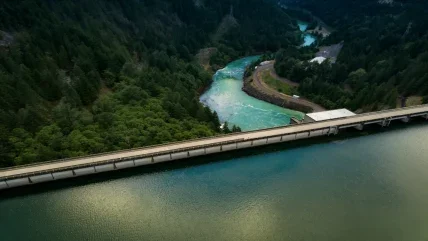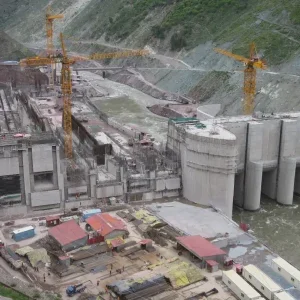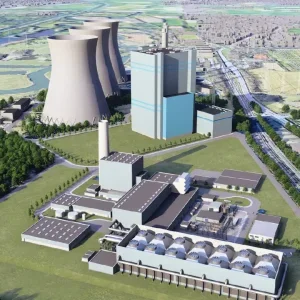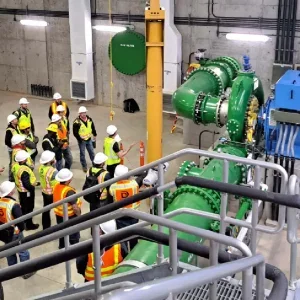
Comprising almost one-third of US renewable energy generation, with pumped storage currently representing 96% of storage capacity whilst supporting grid stability and reliability nationwide, hydropower has a key role to play in the country’s energy mix.
However, despite the potential of these technologies, as a new report by the National Renewable Energy Laboratory (NREL) states, new public and private investment in hydropower projects of all sizes lags behind other renewable energy generation sources such as wind and solar.
Previous reports by the US Department of Energy have alluded to the fact that by 2050, combined US hydropower and pumped storage generation and storage capacity could increase the existing 100GW by almost 50%. And in an effort to move closer towards achieving this vision, NREL’s new report gives an insight into the current hydropower investment landscape, reviewing the challenges associated with raising investment for medium-sized hydropower and pumped storage projects (defined as projects with 5-30MW of installed capacity).
Called ‘Hydropower Investment Landscape’, the new report is based on 33 stakeholder interviews, a survey of 36 industry representatives (including investors), and an analysis of recent public transactions. With more than 1GW of capacity in the current pipeline of medium-sized hydropower and PSH projects (as of 2022), investment required to develop this could range from US$3.16 billion to $9.5 billion, and encompasses five project types: capacity additions, conduits, PSH (both open- and closed-loop), non-powered dams, and new stream-reach development.
Long development timelines, the ability to identify adequate compensation opportunities, and cost competition with other renewables, can make it difficult for hydropower developers to attract debt and equity financing. Although there are signs of new market activity, many developers are forced to self-fund projects to get over early-stage development hurdles. As the NREL report states, development risks can be summarised into six main areas:
- Long project development timelines: Protracted federal, state, and local regulation processes create challenges for project developers and investors alike that add significantly to a project’s financial uncertainty.
- Lack of access to early-stage funding: Early-stage project risks and long lead times to operational cash flows discourage investors from project involvement until permitting and licensing processes are either well underway or complete.
- Challenges in securing early-stage PPAs: For reasons similar to those described above, off-takers are hesitant to sign PPAs until a project is close to going on-line.
- Market compensation uncertainties and lack of market parity: Grid compensation for services such as capacity or ancillary services vary by market and price levels are volatile, reducing revenue certainty.
- High up-front development costs: Hydropower development requires significant upfront funding, and it can be years before revenue is realised. Together with market uncertainty, this can discourage investors who are seeking favourable near-term return on investment.
- Limited industry awareness: Lack of investor awareness about hydropower’s potential role in complementing high amounts of variable renewable energy restricts hydropower’s market growth.
Stakeholders who participated in the research for this new report, suggested that the DOE and other federal agencies have a significant role to play in incentivising the market for hydropower and PSH going forward. As a next step, it is recommended that DOE investigate seven key areas to spur market growth:
• Provide financing, bridge funding, and other forms of support for early-stage hydropower development.
• Perform research on how market parity may be achieved with other types of renewables for both hydropower and PSH.
• Support the development of updated and improved market models and valuation methodologies.
• Create more awareness around federal permitting and licensing processes, and how these processes can be demystified.
• Continue to support research on reducing deployment time and costs.
• Conduct outreach with developers and other industry stakeholders prior to the implementation of new legislation and regulations to help reduce unintended consequences.
• Increase awareness of new opportunities in hydropower.
While no single stakeholder holds the key to unlocking investment, the report states that the DOE can have an important role in reducing the risks and costs in these areas, which should help accelerate future investment.
Ear to the River
In a bid to shed light on the future trajectory of the hydroelectric industry, the National Hydropower Association (NHA), the Ontario Waterpower Association (OWA), the Hydropower Foundation, and Kleinschmidt Associates have revealed the findings of the third annual “Ear to the River” survey. Launched in 2021, this initiative aims to provide crucial insights into the challenges and opportunities anticipated by owners of hydroelectric facilities and professionals in the hydro and broader renewable energy sectors over the next few years.
“The Ear to the River survey serves as a vital tool in understanding the pulse of the North American hydroelectric industry,” says Marla Barnes, Vice President of Member and Industry Engagement at the National Hydropower Association. “It provides valuable insights into the key challenges and opportunities we face. The data from this survey informs industry stakeholders and plays a crucial role in advocating for policies that support a clean energy future.”
“Each year, the annual Ear to River survey provides the OWA with valuable information and insights regarding the key opportunities and challenges facing the waterpower industry. The report will continue to both guide and support our advocacy efforts in the future,” added Janelle Bates, Director of Communications and Member Relations at the Ontario Waterpower Association.
The survey predicts a surge in pumped storage projects, with almost 80% of respondents anticipating projects larger than 500MW in the next decade. However, hurdles such as high capital costs and regulatory challenges loom large.
Regarding dam safety, the industry expects a shift towards more advanced inspection methods, with over 60% anticipating the use of drones and robots in detailed inspections within the next three to five years. And in terms of investment, there’s a positive outlook with over 30% of US asset owners planning significant spending on refurbishments and upgrades in the next five years. The release of grant funding is anticipated to stimulate further investment, with grants identified as the most important government programmes for capital investments by over 70% of respondents.
One of the central findings of the 2023 survey is the persistent challenge of workforce shortage, with 56% of respondents identifying it as the most pressing issue for the hydro industry in the next three to five years. Tim Oakes, Business Sector Leader at Kleinschmidt, emphasised the need for greater promotion of hydropower as a career choice. “The 2023 survey results show that workforce remains the most pressing challenge for the industry and that we’re not doing enough to promote hydropower as an excellent career choice,” he said.
Despite workforce challenges, the survey revealed that nearly 80% of respondents expressed satisfaction with working in the waterpower industry. However, there’s a significant gap in promoting hydro as a career, with less than 30% of respondents entering the industry out of interest in waterpower.
On the front of equity, diversity, and inclusion (EDI) initiatives, progress is noted. While the 2022 survey indicated low participation in EDI, the 2023 results showed improvement, with approximately 80% of NHA respondents and 87% of OWA respondents reporting having EDI policies in place.
Marine MoU
The National Hydropower Association has also been collaborating with Marine Renewables Canada (MRC), in what has been described as a landmark move at leveraging marine energy for global net zero objectives. To solidify their commitment to collaborative advancement and knowledge exchange in marine energy development, the two organisations recently signed a Memorandum of Understanding
Marine energy is described as holding immense promise in decarbonising energy portfolios across the two countries. In the US alone there’s an estimated of 2300TWh annually, and harnessing just a fraction of this could supply 5.6% of total electricity generation. To put this in perspective, domestic installed hydropower and solar power capacity each contributed roughly 5.6% of total US electricity in 2023.
Canada boasts some of the globe’s most auspicious tidal, wave, river current, and offshore wind energy. Over the past decade, the nation has made substantial headway in nurturing its marine renewable energy domain, with ongoing tidal energy initiatives in the Bay of Fundy and endeavours to substitute diesel in remote communities with marine energy alternatives.
Elisa Obermann, Executive Director of Marine Renewables Canada, voiced confidence in the collaboration, remarking: “At this stage in industry development, we need to work together to advance marine energy to a truly commercial clean energy solution.”
“While progress is being made in the marine energy sector, there are still challenges to growing the sector in the US and internationally,” Malcolm Woolf, President and CEO of NHA acknowledged. “By working more closely with Marine Renewables Canada, we hope to collaborate on key challenges, build partnerships amongst our memberships, and share information and best practices that can help accelerate the sector’s development.”
Hydropower outlook
Looking back at last year, according to a recent forecast by the US Energy Information Administration’s Short-Term Energy Outlook (STEO), US hydropower experienced its lowest levels since 2001. However prospects are now looking up for 2024 as hydropower generation is expected to increase by 6%, accounting for 250 billion KWh of electricity.
More hydro is generated in the Northwest and Rockies region than any other region of the US, and although 43% of the country’s hydropower generation occurred here in 2023, this was the region’s lowest since at least 2010. Water supply last year, particularly in Washington and Oregon, was affected by a May heatwave that quickly melted the snowpack and reduced water supply for the rest of the year. However, 106 billion KWh is expected to be produced in the Northwest and Rockies region throughout 2024, 3% more than in 2023.
The largest regional increase in hydropower will come from the Southeast region this year, expected to increase by 4 billion KWh when compared with 2023. This region includes Alabama, Tennessee, and North Carolina, which combined account for about 10% of total hydropower generating capacity in the US.
Although California’s water supply is susceptible to drought, as it was a very wet year last year, annual hydropower generation increased by more than 80%, from 17 billion KWh in 2022 to 31 billion KWh in 2023. STEO expects similar hydropower generation in California this year.
Across the rest of the US, hydropower is expected to increase in nearly every region, with notable increases in New York and the Central region. About 6% of US hydropower generating capacity is located in New York, and STEO expects the state’s hydropower output to increase slightly, to 29 billion KWh.
Such an anticipated rise in hydropower is described as reflecting a positive outlook for the rest of the US energy sector for 2024. Lindsay Aramayo, principal contributor to this analysis, underscores the importance of closely monitoring water supply forecasts and their impact on hydropower generation which remains susceptible to year on year fluctuations.
Columbia River powers on
Plunging temperatures across the Pacific Northwest during January 2024 were no match for the Federal Columbia River Power System (FCRPS), according to a statement issued by Bonneville Power Administration (BPA). Despite record-breaking energy demand and other challenges, the federal power system supported its utility customers and the region through the most intense cold snap the Northwest had seen in 20 years.
“The federal dams were vital to keeping the lights on during this dangerous freezing weather event,” said Power Services Senior Vice President Suzanne Cooper. “While other generation experienced outages, federal generation operated reliably. This performance combined with activity in the wholesale power market allowed us to meet our customers’ load and help supply others during this event.”
“There were challenging pockets throughout the system caused by physical damage to equipment, but our real-time staff made adjustments to preserve reliability, and our field teams did an excellent job of safely responding to interruptions in really challenging weather conditions,” said Ricky Bustamante, acting vice president of Transmission System Operations.
BPA explained that serving consistently high energy demand took significant coordination with multiple partners for both proactive planning ahead of the weather and real-time adjustments as conditions evolved. During the day, BPA ramped up the output of the FCRPS as electricity demand climbed and used power imports or purchases, and during light load hours at night it held water back to maximise power generation and meet peak demand, helping BPA to keep the lights on for the duration of the cold snap.
Leading up to the event, BPA coordinated with the US Army Corps of Engineers and the US Bureau of Reclamation to delay planned maintenance, ensuring the FCRPS had as many units available as possible. Due to a low water year this year, BPA’s planned winter operations were managing the river to minimum flows. The requirement to save water above Grand Coulee for spring fish operations limited the amount of additional generation during the arctic event; however, creative management of the lower Columbia projects allowed BPA to increase generation without reducing the amount of water in Grand Coulee’s reservoir needed for springtime.
Leading up to the impending cold snap, operations also focused on creating storage space in the lower Columbia projects so upstream projects could increase generation without increasing flows below Bonneville needed to protect Endangered Species Act-listed salmon. This led to about 525MW of extra generation, while BPA also worked with Canada to release extra water from Canadian storage reservoirs which provided an additional 600MW.
The lower Snake River dams also made major contributions to BPA’s efforts to keep the lights on during the cold snap. Combined, Lower Granite, Little Goose, Lower Monumental and Ice Harbor dams peaked to more than 1000MW each day, with the highest one-hour peak at 1146MW. This was accomplished by reducing generation late at night into the early morning hours to less than 200MW and ramping to over 1100MW during the peak daytime hours. In addition to peaking performance, Ice Harbor Dam provided much needed local energy in the Tri-Cities area by increasing minimum generation throughout the extreme weather event.
BPA added that the lower Snake River dams also registered an impressive, 18-hour sustained peak during the cold snap, where a sustained peak measures the highest six hours per day of generation over a three-day period.
Opposition
US Senator Jim Risch of Idaho has doubled down in his opposition to breaching and removal of federal dams on the Columbia-Snake River System, saying that plans have “completely excluded Idahoans who rely on the river system for its energy, transportation, agriculture, and recreation benefits. I will continue to fight any breaching efforts,” he commented.
Following four years of comprehensive scientific study of the Columbia River System Operations, the US Army Corps of Engineers, Bureau of Reclamation and Bonneville Power Administration released a record of decision in September 2020 affirming the four dams’ critical importance to the region. Risch says that the Ice Harbor Dam, Lower Monumental Little Goose and Lower Granite Dams provide multiple benefits to Idaho and the region, including:
- Transportation of more than 15 million metric tons of wheat in 2020 with nearly 10% of all US wheat moving out on the Snake River alone.
- US$686 million in jobs and businesses associated with Idaho’s Port of Lewiston, the furthest inland port on the West Coast.
- A 95% emission-free power portfolio generated by BPA, allowing small public utilities across the Northwest to lead in clean energy production.
- Clean, always-on energy that can uniquely keep the lights on during extreme weather events where relying on wind and solar would cause blackouts.
- Irrigation.
In February 2024, Risch went on to insist the Department of Energy addresses the financial burden breaching the lower Snake River dams would have on Idahoans who benefit from the power generated. He says that the analyses of cost implications of breaching the four dams have so far been “incomprehensive”, and “even conservative estimates have recognised the costs would be staggering”.
Risch was joined by four other US Senators who represent Wyoming, Montanna and Idaho in sending an open letter to Jennifer Granholm, Secretary at the Department of Energy.
“The economic burden on northwest public power utilities and ratepayers is unjustifiable. This says nothing for growing demand for more electricity at all times and the need for reliability,” the senators wrote. They added that such plans will threaten the future of hydropower and are not consistent with Granholm’s previous assertion that “we should be expanding and not reducing” hydropower.
As the four Lower Snake River dams have a nameplate capacity of 3000MW and often supply up to a quarter of the reserve capacity BPA needs to balance the entire power system, the senators added that the loss of this would have dire consequences for the citizens in the Northwest.
“With an expected 25% electric demand growth in the region, we should be exploring opportunities to expand generation capacity, not dimmish our most reliable resources,” they commented.
200th anniversary
The US Army Corps of Engineers (USACE) has commemorated the 200th anniversary of its Civil Works programme, “something that makes USACE unique among the world’s military organisations,” Lt. Gen. Scott A. Spellmon said. “Our abilities to cohesively perform military, civil, and research and development missions have enabled us to take on and find solutions for many of our nation’s toughest challenges both at home and abroad,” he added.
The beginnings of the Civil Works mission for USACE are based on legislation passed by Congress and signed into law by President James Monroe in 1824. Over the following 200 years, Congress and administrations approved additional pieces of legislation that expanded and defined what is the current USACE civil works mission. These included:
- The 1928 Flood Control Act which adopted a comprehensive plan for flood control on the Lower Mississippi River, including the use of floodways and spillways in addition to levees.
- The 1936 Flood Control Act made flood control a federal policy and officially recognised USACE as the major federal flood control agency.
- The 1944 Flood Control Act authorised USACE to develop water projects in the Missouri River Valley and further authorised USACE to provide fish and wildlife management and public outdoor recreation facilities at its projects.
- 1986 – The Water Resources Development Act of 1986 brought major change in financing by requiring non-federal contributions toward most federal water resources projects.
The USACE said its Civil Works programme today touches millions of American lives daily through goods and products that are delivered via ports, harbours and waterways; the production of clean, renewable hydropower; water supply for residential, commercial and irrigation use; habitat for fish and wildlife; and recreational opportunities.
In April 2024, USACE also announced that the first-ever comprehensive guidelines for US levees were available for public comment until 31 July 2024. The National Levee Safety Guidelines are intended to provide best practices and serve as a resource to help achieve nationwide consistency in improving the reliability of levees and the resilience of communities behind them.
The National Levee Safety Programme, a joint effort between USACE and the Federal Emergency Management Agency, developed the guidelines with input from stakeholders. Topics in the draft first edition range from basic levee concepts and terminology to strategies for reducing flooding impacts to people, property, and the environment. Considerations for climate change impacts, integrating natural and nature-based features, and the needs of under-served communities are woven throughout the document.
Feedback on the scope of the National Levee Safety Guidelines from stakeholder engagement efforts over the past two years also included the need for levee vegetation management practices. USACE says that high-level best practices have been incorporated into several chapters and will be expanded in the future.
“With thousands of communities across the country depending on levees to reduce impacts from flooding, this is a significant milestone,” says Tammy Conforti, USACE lead for the National Levee Safety Programme. “Levees are designed, constructed, and managed by various entities. There has been a long-standing need to have a common reference to connect all the important practices related to levees. The guidelines provide a common framework to improve public awareness and serve as a basis for continuous dialogue and improvement of practices well into the future.”
Canadian perspectives
Hydro-Québec announced in February 2024 that the modernisation of the Beauharnois–Les Cèdres complex in Canada will start with the draft design ahead of the project to overhaul Coteau-1 and Coteau-3 dams. This rehabilitation project, which is expected to start in 2029, will ensure both of the dams’ long-term operability and increase their capacity in compliance with current standards.
Potential project scenarios will be assessed during the draft design, which will be completed in 2026, and include:
- Consulting local Indigenous and non-Indigenous communities to develop a project that integrates their goals.
- Coordinating all studies required to define the technical content, constraints, permitting requirements and impacts on the environment.
- Developing the project execution strategy.
- Identifying and managing project risks.
- Developing schedules and project estimates.
“This draft design study is a first step towards the modernisation of the Beauharnois–Les Cèdres complex. In the decades ahead, our infrastructure renovations will require investments, and we want to involve stakeholders from the outset to ensure the project’s social acceptability,” said Yannick Chevrier-Bédard, Manager of Construction Projects.
Built by the Beauharnois Light, Heat and Power Company, Coteau-1 (built in 1933) and Coteau-3 (built in 1940) are two of four dams designed to regulate water levels in Lac Saint-François, and facilitate the flow to the Canal de Beauharnois and the headrace canal for Les Cèdres generating station.
Spanning 320m, Coteau-1 dam has 20 openings with 18 gates, while Coteau-3 dam is 270m long and has 16 gates. The necessary rehabilitation work is part of a broad portfolio of major investments to modernise the Beauharnois–Les Cèdres complex and will be carried out in addition to the priority work that began in 2021 based on surveys of all the structures on the Fleuve Saint-Laurent (St. Lawrence River) and Canal de Beauharnois.
In May 2024, the Conseil des Innus d’Unamen Shipu and Hydro-Québec signed the Mishta Uashat Lac-Robertson Agreement following its approval by the Government of Québec. In a spirit of mutual respect and trust, the agreement aims to resolve all outstanding disputes related to the construction, operation and maintenance of the Lac-Robertson development, which includes a 21MW hydropower station on the Rivière Ha! Ha!
Lac-Robertson generating station has been the subject of various legal challenges and claims from the community of Unamen Shipu. The new agreement formalises the intention of both the community and Hydro-Québec to forge a mutually beneficial, long-term relationship based on respect, cooperation and trust. Under this agreement, Hydro-Québec will pay a total of C$32million to the Conseil des Innus d’Unamen Shipu in the form of annual payments over a 23-year period. These funds will provide the community with revenues that it will allocate to priorities of its own choosing.
“Building trust to foster partnerships between Hydro-Québec and Indigenous communities is important,” said Pierre Fitzgibbon, Minister of Economy, Innovation and Energy. “This agreement helps create the conditions that will allow us to meet the challenges of the energy transition together.”
“This agreement with Unamen Shipu is based on two fundamental principles of economic reconciliation. First, it’s a step towards acknowledging and settling past grievances. And second, it creates a source of revenues that the community can invest in its own priorities in the years to come,” Hydro-Québec’s President and CEO, Michael Sabia, acknowledged.
Lewis Ridge
Rye Development has been selected by US Department of Energy to receive $81m for Lewis Ridge Pumped Storage Project, under the DOE’s Clean Energy Demonstration Programme on Current and Former Mine Land. The Lewis Ridge Project will be one of the first pumped storage hydropower facilities constructed in the US in more than 30 years, and the first ever to be built on former mine land. As a closed-loop pumped storage facility, Lewis Ridge will leave existing waterways and wildlife undisturbed.
“This project is not only a significant investment in Kentucky; it’s an investment in strengthening our national electricity grid, helping to secure our energy future,” said Paul Jacob, CEO of Rye Development. “The Lewis Ridge Pumped Storage Project will protect against blackouts and brownouts, while transforming a former mining site into a long-term economic engine for the region.”
Seeking collaboration
Idaho National Laboratory (INL) is seeking a hydropower utility to collaborate on a case study, funded by the DOE’s Water Power Technologies Office, to understand how small hydroelectric plants operating at 10MW or less can be upgraded to provide emergency power to critical loads (such as hospitals and emergency service providers) during outages.
INL’s Hydro Hybrids team developed guidelines for modifying run-of-river power plants, which typically rely on power from the grid when the facility is starting up or otherwise not already generating electricity. The study would determine the necessary upgrades for a plant to restart and maintain emergency services in a blackout without any external power from the grid (referred to as “black start”).
There is no cost-share commitment, but INL would require the utility to provide plant specifications and data. INL staff will protect the data during the project, and anonymised data will be published in the case study to inform other hydropower owners.
This effort builds on the successes of previous field demonstrations. In 2021, INL partnered with Idaho Falls Power, a municipally owned utility, to demonstrate how its five hydropower plants could be configured and modified to improve frequency response and maintain stability with larger loads during black start when paired with an ultracapacitor.
INL also collaborated in 2023 with Fall River Rural Electric Cooperative to show how retrofitted and upgraded plant components and systems (hydro-governor controls and protection circuits) could allow the co-op’s hydropower plants to run independently from the grid to provide emergency power to critical loads.
“The current call for collaborators is not intended to seek field test participants, but to gather specific data needed to design a minimal upgrade package that facilitates black starting small hydropower plants,” says Yemi Ojo, a clean energy postdoctoral research associate for INL.
This article first appeared in International Water Power magazine.






